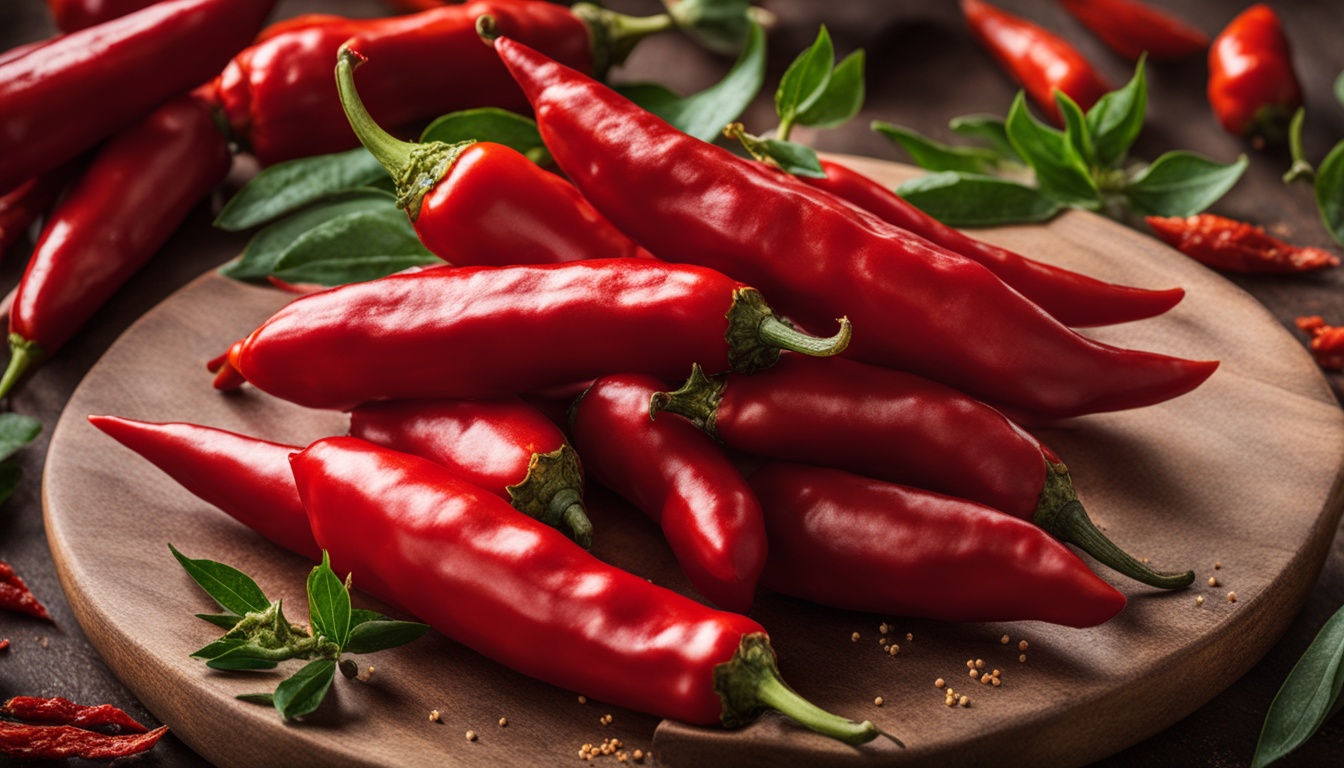I love the bold flavors of paprika in my cooking. This spice can make simple dishes taste amazing. It adds a smoky taste to grilled meats and a sweet touch to roasted veggies.
This guide will show you the world of paprika. We’ll look at its origins, types, and how to use it in cooking. If you love spices or want to try new things, you’ll find something interesting here.
What is Paprika?
Paprika is a spice that has been in kitchens for centuries. It comes from dried and ground red peppers of the Capsicum annuum species. This spice is a key ingredient in many cuisines, especially in Central Europe.
Paprika’s Origin and Production
Paprika started in Hungary, where it’s loved for generations. The peppers are grown, dried, and ground into powder. This careful process makes each paprika unique, from sweet to smoky.
Varieties of Paprika
- Sweet Paprika: Mild, with a rich, earthy flavor and a deep red hue.
- Smoked Paprika: Also known as Pimentón, this variety is dried over oak fires, resulting in a captivating smoky aroma and taste.
- Hot Paprika: Boasting a fiery kick, this type of paprika is perfect for adding a burst of heat to dishes.
- Hungarian Paprika: Renowned for its vibrant color and complex flavor, Hungarian paprika is a beloved staple in traditional Hungarian cuisine.
- Spanish Paprika: Crafted in Spain, this paprika offers a range of flavors, from sweet and mild to robust and smoky.
Looking to add warmth to your dishes or start a new culinary adventure? Paprika offers a world of flavors to try.
The Distinctive Flavors of Paprika
Paprika is a spice that brings many flavors to the table, from sweet to smoky. Knowing the differences between paprika types can make your cooking better.
Sweet vs. Smoked Paprika
Sweet paprika, or Hungarian paprika, has its seeds and veins removed. This makes it milder and fruity. It’s great for adding warmth and color to dishes without being too strong. Smoked paprika, or Spanish paprika, is dried over oak fires. This gives it a smoky smell and taste.
Hungarian vs. Spanish Paprika
Hungarian and Spanish paprikas have different tastes. Hungarian paprika is sweeter and milder. Spanish paprika is smokier. Hungarian paprika is best for light dishes. Spanish paprika is great for grilled or roasted foods.
| Characteristic | Hungarian Paprika | Spanish Paprika |
|---|---|---|
| Flavor Profile | Sweet and mild | Smoky and bold |
| Typical Uses | Seasoning delicate dishes | Enhancing heartier, grilled or roasted recipes |
| Spice Level | Mild to medium | Medium to hot |
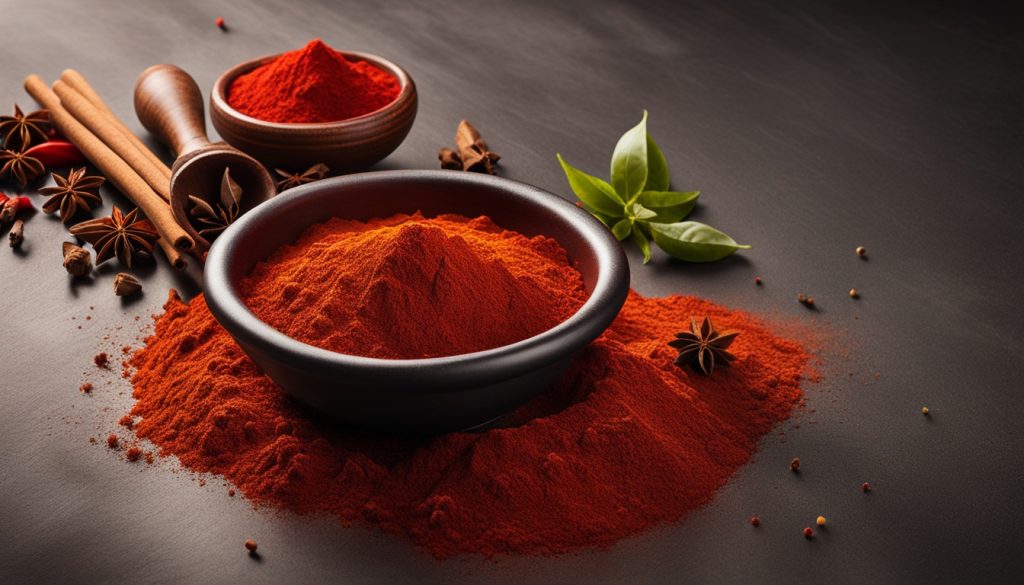
Exploring paprika’s unique flavors can really change your cooking. Whether you like Hungarian paprika’s sweetness or Spanish paprika’s smokiness, knowing the differences lets you make amazing dishes.
Paprika: More Than Just a Garnish
Paprika is often seen as just a garnish, but it’s so much more. It can make many dishes taste better, from stews to marinades. This spice adds color and flavor to food.
Paprika makes proteins and veggies taste sweeter. It’s great for grilling chicken or roasting veggies. A little paprika can make your food taste better.
Paprika uses go way beyond just being a garnish. It can make your cooking richer and more complex. Smoked paprika adds a deep, earthy taste. Sweet paprika brings warmth and sweetness to sauces.
Paprika is a versatile spice that can transform a simple dish into something extraordinary. Its ability to enhance natural flavors and add depth of character makes it an invaluable tool in the kitchen.”
Want to add color and flavor to your dishes? Or try new ways to cooking with paprika? This spice is a must-have in your kitchen.
Unleashing Paprika’s Potential
Paprika’s bright flavor makes it a key spice in many dishes worldwide. It adds depth and color to foods like Hungarian stews and Spanish paellas. This spice is a must-have for many cooks.
Classic Recipes Featuring Paprika
In Hungarian cooking, paprika is vital in dishes like goulash and chicken paprikash. Its smoky, sweet taste goes well with the rich meat flavors. Spanish cuisine also loves paprika, using it in paella and chorizo.
Paprika isn’t just for traditional dishes. It can also make everyday foods like deviled eggs and roasted potatoes taste better. Its color and sweetness can turn a simple dish into something exciting.
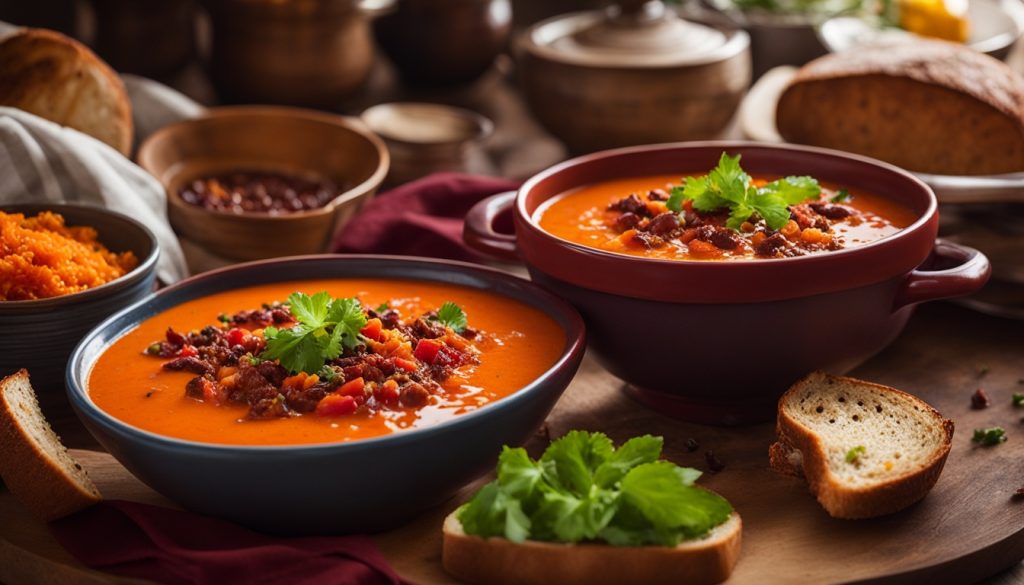
“Paprika is the secret ingredient that takes a good dish and makes it something truly special.”
If you want to spice up a classic recipe or try new tastes, paprika is a great choice. It’s a versatile spice that every home cook should have. Paprika can make your cooking more exciting and flavorful.
Paprika
Paprika is a spice that truly captivates the senses. It comes from dried and ground peppers. This spice has many flavors, from sweet to bold and smoky. It’s a must-have for home cooks, adding flavor to your dishes.
Paprika is very versatile. It fits well in many cuisines, like Hungarian goulash or Spanish paella. It can also be used in savory dishes and even desserts. Paprika adds depth and color to your meals, making it a key spice for home cooks.
| Paprika Variety | Flavor Profile | Common Uses |
|---|---|---|
| Sweet Paprika | Mild, sweet, and slightly fruity | Seasoning for meats, vegetables, and rice dishes |
| Smoked Paprika | Bold, smoky, and slightly spicy | Marinades, rubs, and signature dishes like Spanish paella |
| Hungarian Paprika | Ranging from sweet to hot, with a complex flavor | Stews, braises, and traditional Hungarian dishes |
| Spanish Paprika | Mild, sweet, and slightly earthy | Seasoning for seafood, roasted vegetables, and rice dishes |
Paprika can make simple dishes special. It adds color to deviled eggs and smoky depth to roasted potatoes. Its versatility is unmatched.
“Paprika is the spice that gives my dishes their signature flavor. I can’t imagine cooking without it.”
If you’re a home cook, add paprika to your pantry. Its flavor and versatility will make it a staple in your cooking.
Pairing Paprika with Complementary Flavors
Paprika is a spice that can make many dishes taste better. To get the best out of paprika, know how to mix it with other ingredients. By finding the right pairings, you can make dishes that look great and taste amazing.
Garlic and onion are great with paprika. They balance its sweet or smoky taste. Cumin also goes well, adding a warm, earthy flavor.
For a sweet touch, mix paprika with cinnamon. This mix adds depth to chili, stews, or baked goods. Oregano also pairs well, adding a subtle herb flavor to Mediterranean dishes.
Don’t forget black pepper. It balances paprika’s mild heat, making the flavor rich and complex.
| Complementary Flavors for Paprika | How They Enhance Paprika’s Taste |
|---|---|
| Garlic and Onion | Balances the sweet or smoky notes of paprika |
| Cumin | Adds a warm, earthy depth to the flavor profile |
| Cinnamon | Provides a touch of sweetness to complement paprika |
| Oregano | Lends a subtle herbaceous note to paprika-based dishes |
| Black Pepper | Helps to balance the mild heat of paprika |
Try these flavors to bring out paprika’s best. Whether you want smoke, sweetness, or warmth in your dishes, the right mix can make a big difference.
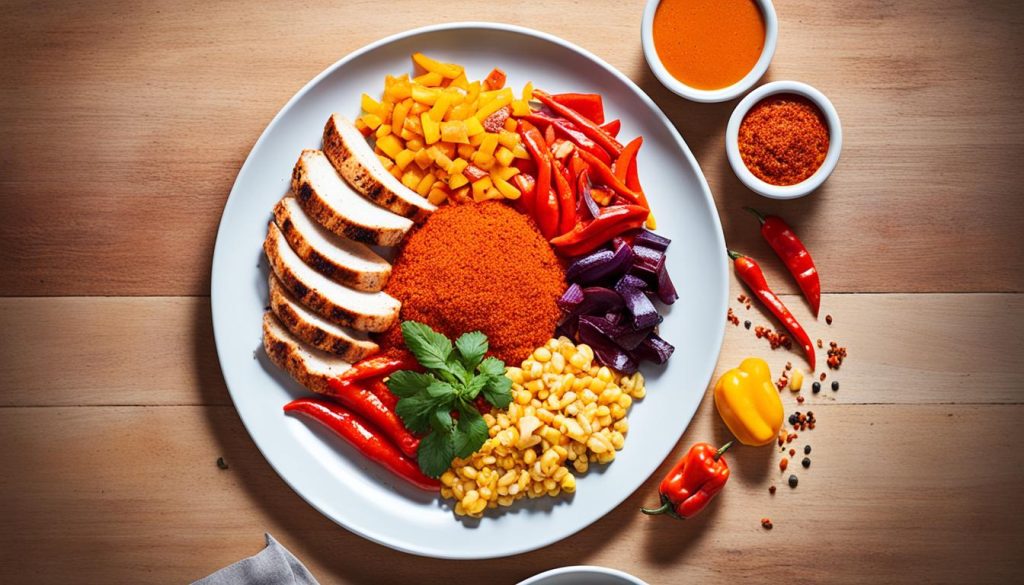
Unlocking the Health Benefits of Paprika
Paprika is more than just a spice that makes food taste good. It’s full of vitamins and minerals that help us stay healthy. Being part of the Capsicum family, paprika is packed with nutrients for our well-being.
Paprika is a great source of vitamin C. Just a teaspoon gives us up to 6% of what we need daily. Vitamin C keeps our immune system strong, fighting off sickness. It also has vitamin A, which keeps our skin healthy and our eyes clear.
Paprika is full of antioxidants like beta-carotene and lycopene. These help reduce inflammation and lower the risk of heart disease and cancer. Adding more paprika to your meals can be a smart way to get these benefits.
| Nutrient | Amount per Teaspoon of Paprika | Percentage of Daily Value |
|---|---|---|
| Vitamin C | 2.5 mg | 6% |
| Vitamin A | 429 IU | 9% |
| Vitamin E | 0.4 mg | 2% |
| Iron | 0.5 mg | 3% |
| Magnesium | 3 mg | 1% |
Adding paprika to your meals is a tasty way to boost your health. Whether you choose sweet or smoked paprika, it’s a key spice for any kitchen.
Storage Tips for Preserving Paprika’s Vibrant Color and Flavor
Keeping your paprika fresh and flavorful is important for any home cook. Proper storage helps you enjoy its full taste. Follow simple steps to keep your paprika fresh for weeks.
First, store your paprika in an airtight container. Air, light, and moisture can make it lose its strength. So, an airtight seal is key for storing paprika and keeping paprika fresh. Also, keep it in a cool, dark place, away from sunlight or heat.
After storing, be careful with how you use it. Don’t open the container too often, as it can lose flavor. Measure what you need for a recipe and put it back. These steps help you maintain paprika flavor and enjoy its bright colors in your cooking.
| Storage Tip | Benefit |
|---|---|
| Airtight container | Prevents loss of potency |
| Cool, dark location | Preserves color and flavor |
| Minimal opening/closing | Maintains freshness |
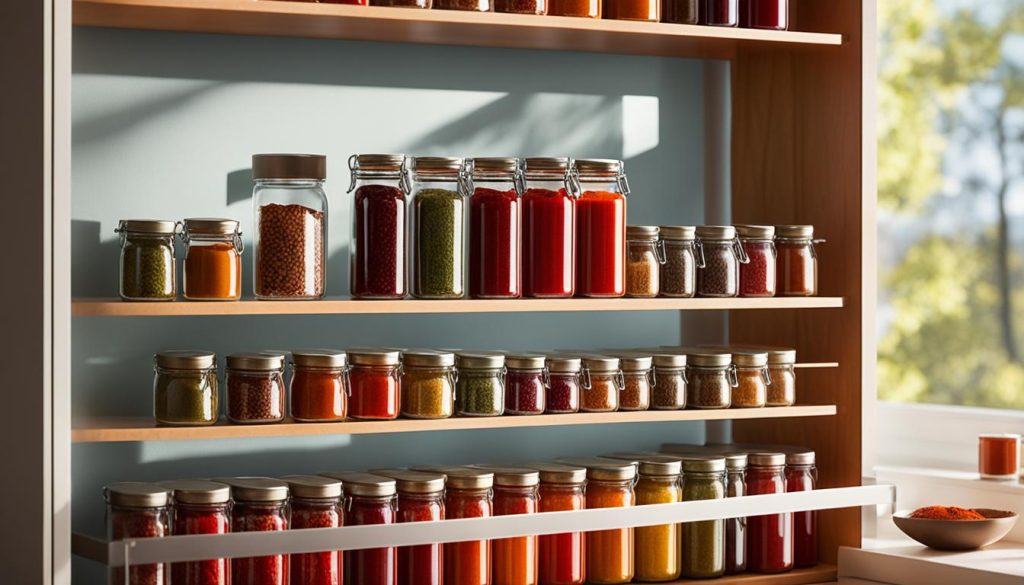
“Proper storage is the key to unlocking the full potential of your paprika. Follow these tips, and you’ll be rewarded with vibrant color and robust flavor in every dish.”
Exploring Global Cuisines with Paprika
Paprika is a spice loved around the world. It’s key in Hungarian and Spanish cooking. This spice makes many dishes taste better.
Hungarian Paprika Dishes
In Hungary, paprika is a big deal. It’s in many dishes, like the famous goulash. This stew has meat, onions, and lots of sweet paprika.
Chicken paprikash is another favorite. It’s a creamy chicken dish with paprika. This shows how paprika can make food rich and tasty.
Spanish Paprika Dishes
In Spain, paprika is also very important. They use a smoked kind called pimentón de la Vera. It adds a smoky taste to many dishes.
Patatas bravas and seafood stews use Spanish paprika too. This spice makes Spanish food bold and full of flavor.
| Hungarian Paprika Dishes | Spanish Paprika Dishes |
|---|---|
| Goulash | Patatas Bravas |
| Chicken Paprikash | Paella |
| Lecso | Chorizo |
Trying different paprika dishes from around the world is exciting. You can taste the unique flavors each place adds. Whether you like Hungarian goulash or Spanish tapas, paprika makes food special.
Crafting Homemade Spice Blends with Paprika
Paprika is great for making your own spice blends. It adds color, sweetness, and flavor to many dishes. Try mixing it with other spices and herbs to make your own seasoning blends.
Creating your own spice mixes lets you pick the flavors you like best. Start with sweet or smoked paprika. Then, add spices like cumin, garlic powder, and chili powder. You can make a seasoning that’s just right for you.
Here are some ideas for homemade spice blends with paprika:
- Barbecue Rub: Combine sweet paprika, brown sugar, chili powder, garlic powder, and smoked paprika for a flavorful rub that’s perfect for grilled meats.
- Cajun Seasoning: Mix paprika, cayenne pepper, garlic powder, onion powder, dried thyme, and dried oregano for a bold, spicy seasoning that’s great for blackened fish, chicken, or vegetables.
- Taco or Fajita Seasoning: Blend paprika, cumin, chili powder, garlic powder, onion powder, and a pinch of oregano for a homemade taco or fajita seasoning that outshines the store-bought versions.
Remember, making great spice blends with paprika is all about trying new things. Start with a little, taste it, and adjust the flavors until you’re happy. Soon, you’ll have a seasoning blend you’ll always use.
| Spice Blend | Paprika Variety | Additional Spices |
|---|---|---|
| Barbecue Rub | Sweet paprika, smoked paprika | Brown sugar, chili powder, garlic powder |
| Cajun Seasoning | Paprika | Cayenne pepper, garlic powder, onion powder, dried thyme, dried oregano |
| Taco/Fajita Seasoning | Paprika | Cumin, chili powder, garlic powder, onion powder, oregano |
“Homemade spice blends allow you to control the flavors and create unique seasoning profiles that perfectly complement your dishes.”
Substitutes for Paprika in a Pinch
Paprika is a key spice in many recipes. But what if you don’t have it? Don’t worry, there are substitutes that can give a similar taste. These options work well whether you need a sweet or smoky flavor.
Chili Powder to the Rescue
Chili powder is a great substitute for paprika. It tastes earthy and a bit sweet, just like paprika. Use it in the same amount as paprika in most recipes. But remember, chili powder is stronger, so start with a little and adjust as needed.
The Fiery Alternative: Cayenne Pepper
Cayenne pepper is perfect for adding heat instead of paprika. It has a bold, strong taste that’s similar to smoked paprika. Use half the amount of cayenne pepper as paprika to get the right heat.
Smoked Paprika: The Smoky Substitute
For a smoky taste like smoked paprika, try smoked paprika itself. You can swap it with regular paprika without changing the flavor much.
When using these substitutes, remember to adjust the amount based on their intensity and heat. Start with a little and add more until it tastes right.
“Spices are the flowers of the culinary world, and paprika is one of the brightest blooms.”
Where to Buy High-Quality Paprika
As a home cook, I know finding the right ingredients is key. For paprika, I look for the freshest and most flavorful options. Stores like Penzeys Spices and The Spice House have great paprika choices, including Hungarian and Spanish types.
Online shopping is also easy with sites like Spice Jungle and World Spice Merchants. They offer many high-quality paprika options right to your door. I’ve also found great paprika at Whole Foods Market and Trader Joe’s, where they pick the best products.
When buying paprika, always check the labels. Look at the color, smell it, and see if it’s fresh. Spending a bit more on a premium paprika can really improve your dishes. With some research and care, you can easily find the best paprika for your cooking.

